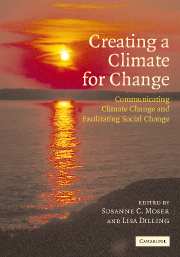Book contents
- Frontmatter
- Contents
- Preface
- Foreword
- List of contributors
- List of tables
- List of figures
- List of text boxes
- Introduction
- Part I Communicating climate change
- 1 Weather or climate change?
- 2 Communicating the risks of global warming: American risk perceptions, affective images, and interpretive communities
- 3 More bad news: the risk of neglecting emotional responses to climate change information
- 4 Public scares: changing the issue culture
- 5 The challenge of trying to make a difference using media messages
- 6 Listening to the audience: San Diego hones its communication strategy by soliciting residents' views
- 7 The climate-justice link: communicating risk with low-income and minority audiences
- 8 Postcards from the (not so) frozen North: talking about climate change in Alaska
- 9 Climate change: a moral issue
- 10 Einstein, Roosevelt, and the atom bomb: lessons learned for scientists communicating climate change
- 11 Across the great divide: supporting scientists as effective messengers in the public sphere
- 12 Dealing with climate change contrarians
- 13 A role for dialogue in communication about climate change
- 14 Information is not enough
- Part II Facilitating social change
- Part III Creating a climate for change
- About the authors
- Index
- References
9 - Climate change: a moral issue
Published online by Cambridge University Press: 20 August 2009
- Frontmatter
- Contents
- Preface
- Foreword
- List of contributors
- List of tables
- List of figures
- List of text boxes
- Introduction
- Part I Communicating climate change
- 1 Weather or climate change?
- 2 Communicating the risks of global warming: American risk perceptions, affective images, and interpretive communities
- 3 More bad news: the risk of neglecting emotional responses to climate change information
- 4 Public scares: changing the issue culture
- 5 The challenge of trying to make a difference using media messages
- 6 Listening to the audience: San Diego hones its communication strategy by soliciting residents' views
- 7 The climate-justice link: communicating risk with low-income and minority audiences
- 8 Postcards from the (not so) frozen North: talking about climate change in Alaska
- 9 Climate change: a moral issue
- 10 Einstein, Roosevelt, and the atom bomb: lessons learned for scientists communicating climate change
- 11 Across the great divide: supporting scientists as effective messengers in the public sphere
- 12 Dealing with climate change contrarians
- 13 A role for dialogue in communication about climate change
- 14 Information is not enough
- Part II Facilitating social change
- Part III Creating a climate for change
- About the authors
- Index
- References
Summary
Introduction
Talking about climate change is difficult at best, but when the subject is raised from the pulpit, it becomes not just difficult, but very complicated and sensitive. Because climate change is often seen as a political issue or even as part of a liberal conspiracy, clergy have to be extremely careful. On the other hand, religious leaders carry an important moral voice in the community, thus they are in a strong position to raise awareness and influence public opinion. This moral voice is increasingly being heard in broad, denomination-wide statements and open letters, some directed at political leaders, others at congregations; it is also being heard at the very local level, where priests and rabbis, ministers, imams, and monks speak to their congregations and communities (see Textbox 9.1). According to polls conducted after the 2004 elections in the United States, moral values played a major role in voters' decisions, thus giving rise to even more important reasons for the moral dimensions of issues such as climate change to be brought up front and center.
Clearly, choosing to speak out on climate change places religious leaders at risk of alienating their parishioners if they are seen as unprofessional or as using the pulpit as a soapbox. There is a thin line between engaging and mobilizing a community around an issue that has important social justice, environmental, and ethical dimensions (undoubtedly a justifiable religious matter) and being dismissed as a political agitator.
- Type
- Chapter
- Information
- Creating a Climate for ChangeCommunicating Climate Change and Facilitating Social Change, pp. 153 - 166Publisher: Cambridge University PressPrint publication year: 2007
References
- 7
- Cited by



